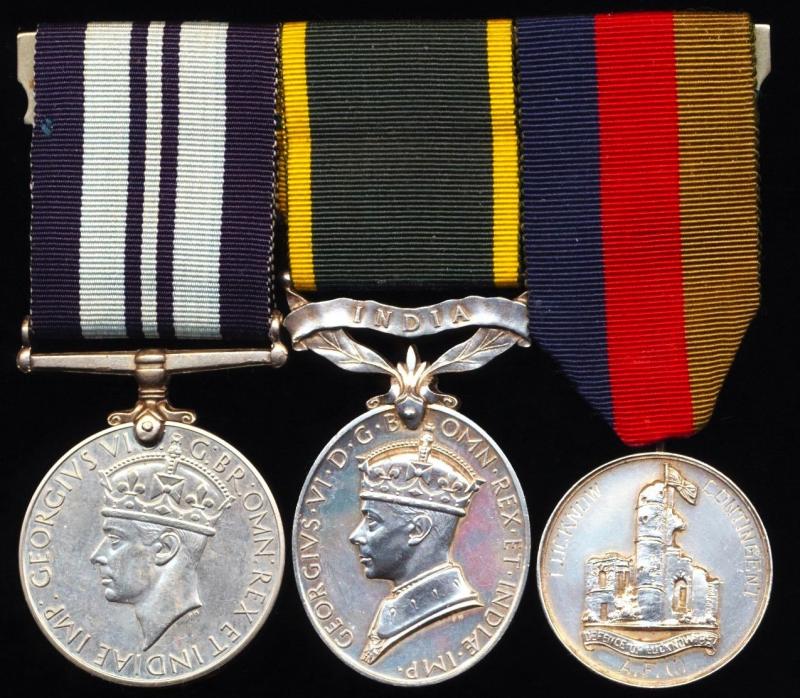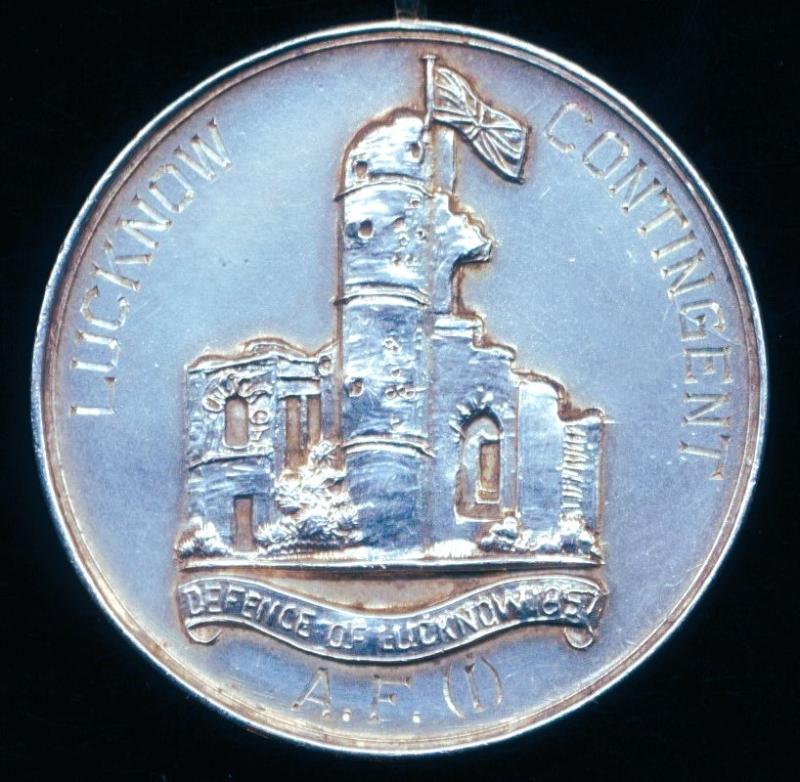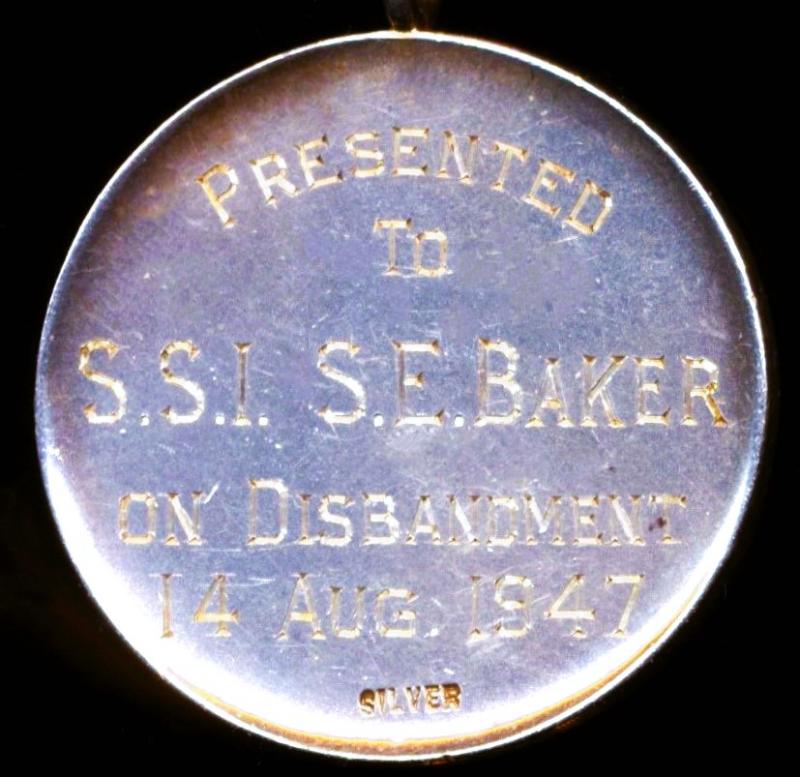A scarce Second World War era regimental group of 3 to the Lucknow Contingent Auxiliary Force India: Staff Sergeant Instructor Stanley Ernest Baker, Lucknow Contingent late Company Sergeant Major, 2nd East Indian Railway Battalion, Auxiliary Force India
- India Service Medal
- Efficiency Medal. GVI first issue with 'India' bar (C.S.M. S.E. Baker. 2-E.I.Ry. R., A.F.I.)
- Lucknow Contingent A.F. (I) Disbandment Medal 1947 (Presented to S.S.I. S.E. Baker on Disbandment 14 Aug. 1947)
Note: The recipient would also have been entitled to a War Medal 1939-1945 for his Second World War service with the Indian Army
Important: The Lucknow Contingent Disbandment Medal is silver (marked silver) and is complete with it's original silk riband in the regimental colours - and an extremely are item of Auxiliary Force India history
All units of the Auxiliary Force India were stood down on 14 August 1947, the eve of Indian independence, on which date the Auxiliary Force India was disbanded. The only unit that appears to have struck a formal 'Disbandment' medal was the Lucknow Contingent. The Lucknow Contingent medal is described below:
- Metal: Silver (marked 'Silver on reverse)
- Dimensions: 31.5mm
- Riband: Tricolour of equal widths in regimental colours Navy Blue / Red / Olive Green (same colours as worn on the Pagri and uniform flashes)
- Weight: Approximately 16g
- Obverse: Die struck medal with depiction of Lucknow Residency, with Union Flag flying and below an honour scroll 'Defence of Lucknow 1857' & engraved 'Lucknow Contingent A.F. (I)'
- Reverse: Plain except for engraved naming details 'Presented / To / S.S.I. S.E. Baker / On Disbandment / 14 Aug. 1947
Lucknow Residency & Flagstaff Tower: The only location in the erstwhile British Empire where the Union Flag flew 24 hours a day 357 days a year, was the preserved 'Flagstaff Tower' at the remains of the former Lucknow Residency. Such was the British sensitivity to that hallowed ground, that just minutes before the stroke of midnight on 14 August 1947 - and before Indian emerged as an independent state - a secret deployment of chosen personnel from British Army personnel of the Royal Engineers were deployed to the Flagstaff Tower to draw down the Union Flag, and blow-up the flagstaff. The destruction of the flag-staff, being a calculated act to defy Indian Nationalists from immediately running up a triumphal 'Tricolour' to mark their independence. The last Union Flag to fly at Lucknow was subsequently returned to the United Kingdom, where the flag was presented to the His Majesty King George VI, the former King Emperor!
In August 1947. the recipient, was a Staff Sergeant Major Instructor then serving with the Lucknow Contingent of the Auxiliary Force India
Stanley Ernest Baker, son of John Alfred Baker (shown variously as Farm Engine Driver / Agricultural Labourer) & Maria Baker (nee Bore), was a native of the parish of Boxford, Ipswich, Suffolk, England, where he was born sometime in 1901 - his birth was registered during the last quarter of 1901. For some reason, Stanley's name appears registered as 'Ernest Stanley Baker', both in his birth record (1901) the 1911 National Census. Stanley was one of 10 children in the family, and his 9 x siblings comprised, 3 x sisters, & 6 x brothers. Stanley enlisted in the British Army, at Warley, Suffolk, England, on, 24 July 1919, at which time he was given the regimental number 77903, which in 1920, was changed to the unique Army Number 532472 (Royal Tank Corps enlistment registers refer). in 1919, the family residence was located at, 21 White Street Green, Boxford, Suffolk. Prior to his attestation he had been employed as a 'Labourer'. Stanley was posted to the 4th Hussars, and embarked for service in British India with his regiment on, 17 September 1921. While serving at Meerut Cantonment with his regiment, and holding the rank of Lance-Sergeant, he married Ivy Rosamont Hansford (23 years of age) at Lucknow, on, 20 April 1928. Stanley subsequently took his final discharge from the British Army on, 23 July 1931, and thereafter took up an appointment with the East Indian Railway Company, with which company he was employed as a 'Guard'. Residing in Lucknow, Stanley joined the local railway Auxiliary Force Indian unit, 2nd Battalion East Indian Railway Regiment in which unit he was holding the rank of Company Sergeant Major when he was awarded his 'Efficiency Medal'. Stanley, married for a second time at Lucknow, on, 20 September 1937, described as 'Widower', he married a divorcee Beryl Mae (or May) Mackrodt (a twice married 43 years old 'Nurse', and daughter of Arthur D'Cruz). At the time of his second marriage the couple were residing at, 11 Banks Road, Lucknow. During the Second World War, Stanley joined the Indian Army and remained in India on non-operational war service, for which he qualified for the India Service Medal (3 years exclusive service in India), and would have been awarded a War Medal for the usual 28 days service. In the time leading up to the independence of India, Stanley had been serving as a Staff Sergeant Instructor with the Lucknow Contingent (his local A.F.I. unit). Shortly following the independence of India, Stanley and his family, including his wife and 3 x daughters (Margaret 19, Shirley 14 & Pamela 10) left India and relocated to the United Kingdom, where on 20 October 1949, the family arrived at Southampton and initially resided at Stanley's home-town, at, Brook Hall, Boxford, Suffolk, England. Stanley and his family relocated to Leeds Yorkshire, England, where the family lived from the 1950's. Stanley Ernest Baker is recorded to have died on, 9 October 1984, at Leeds, Yorkshire, England. At the time of his death, he had been living at, 15 Linden Avenue, Leeds. His body was interred at Hunslet Cemetery, Hunslet, Leeds, England. At the time of his death, he was a 'Widower', his wife Beryl having preceded him in 1964, and whose body was laid to rest at the same Hunslet Cemetery
The medals mounted on a contemporary three space white metal mounting bar. This latter now sans pin and clasp fittings. The medals all suspended from their original silk ribands
Condition: Mostly GVF
Code: 23453







